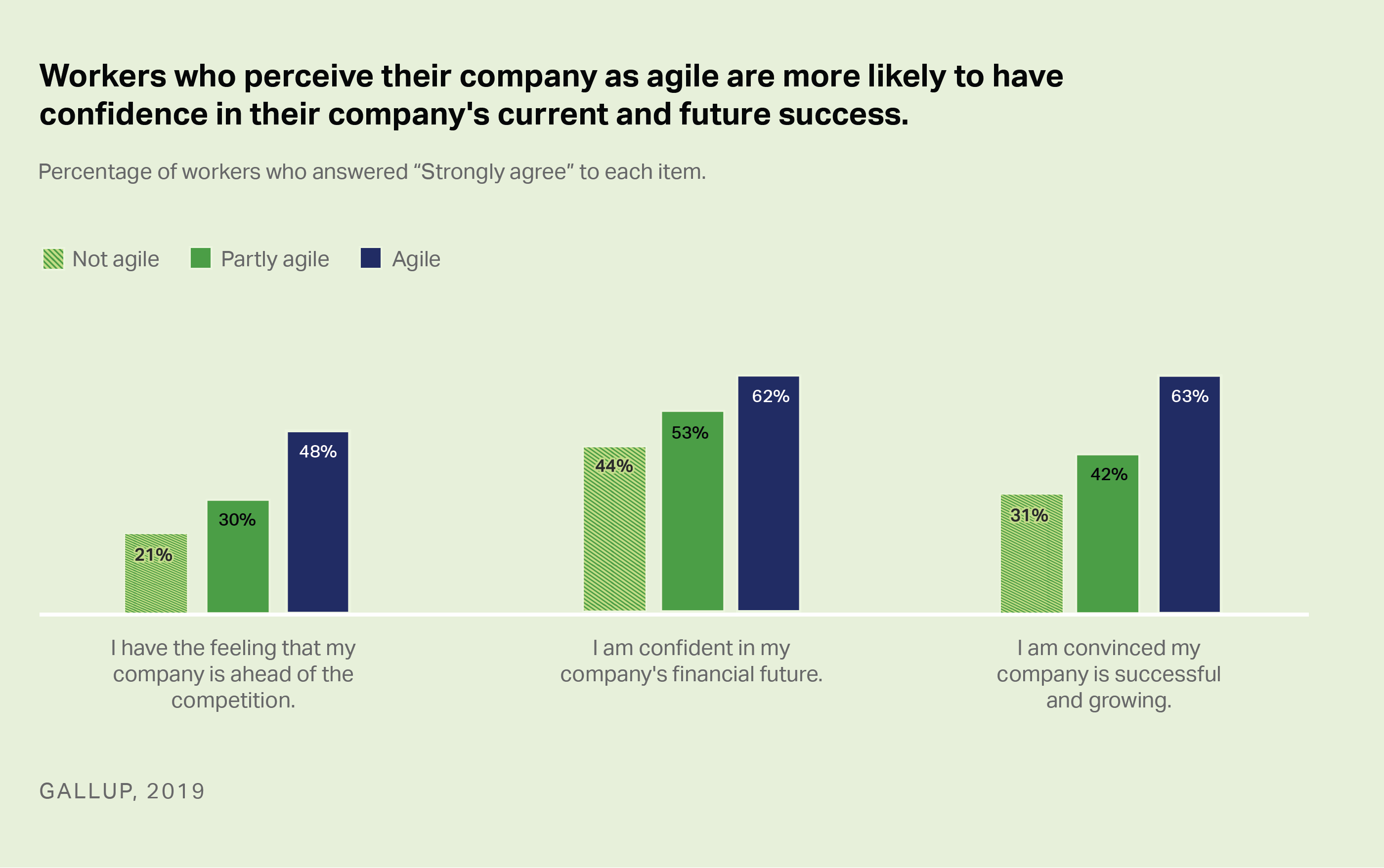Story Highlights
- German companies are making major strides in agility
- Ten traits underpin successful agile cultures
Among all the bad news recently is this positive discovery: German companies are perhaps becoming much more agile.
In fact, Gallup's Agility Index shows an eight-percentage-point increase -- from 9% in 2019 to 17% in 2020 -- in German workers who strongly agree their company has the right mindset, tools and processes to respond quickly to business needs.

Bar graph showing that agility in Germany has increased from 9% in 2019 to 17% in 2020.
That's good news indeed. Gallup research shows that when workers perceive their culture to be agile, they're more likely to believe that their company is ahead of the competition, that the company's financial future is secure, and that their employer is successful and growing.
There's good reason for their optimism -- highly agile companies show vastly better financial performance than companies that incorporate limited agile principles, according to the Project Management Institute, and nine in 10 executives say agility is critical for business success.

Bar graph showing that workers who perceive their company as agile feel their company is ahead of the competition, financially secure, successful and growing.
Capitalizing on agility
Employees who report organizational agility are signaling confidence in their company and its future, which is important information for their leaders.
Employees know where things stall, where decisions come too slowly, where conflict arises, where friction erodes cooperation and where disempowerment causes disengagement -- or just the opposite.
In fact, employees who strongly agree they have the tools, processes and mindset of agility usually agree as well that their company also has eight cultural attributes that drive a culture of agility.
Gallup research shows that when workers perceive their culture to be agile, they're more likely to believe that their company is ahead of the competition, that the company's financial future is secure, and that their employer is successful and growing.
If employees' perception of the "Agility Eight" is negative, leaders know where to find opportunities for optimization. Negative responses provide practical, granular information.
But positive responses to the Agility Eight indicate important -- and easily undervalued -- cultural principles that could set the stage for agility.
Gallup discovered these principles in its studies of highly agile companies. Distinct from the Agility Eight, the following principles underpin agility:
- A unified vision across the organization.
- Customer-focused and performance-oriented cultures.
- Diverse talent that excels in a fast-changing environment.
- Leaders and managers who are developed to coach and empower.
- Dynamic teams structured and networked to focus on key priorities.
- Leaders who make timely, quality decisions.
- Targeted, sensible and just-in-time communication.
- Stable, highly adaptable core operating processes.
- The mindset to pursue simplicity and thrive in complexity.
- Technology that purposefully enhances customer and employee experiences.
Assessing these principles in a culture gives leaders a priori information about a business' ability to succeed on the Agility Index -- or explain why it failed.
Agility: The sooner, the better
Many more leaders are getting positive results on their culture assessment and Agility Index score. But most, unfortunately, aren't. They're losing profit, productivity and, often, employee engagement -- which is already stubbornly low in Germany.
That's not good news, and it gets worse. The European Commission expects the eurozone economy to grow by 3.8% between today and 2022 due to a sharp uptick in consumer spending. Though the commerce is welcome, that spending will put pressure on businesses still reeling from pandemic-era labor and supply shortages. And a lack of agility compromises customer centricity.
Agility comes from every part of an organization
Clearly, agile companies have a competitive advantage over nonagile ones. But organizations can narrow the gap with scientifically valid measurement tools, selection instruments, training and coaching, restructuring to refine teams and jobs, process optimization, and internal branding and communication strategies with an emphasis on behavioral science and comprehensive approaches.
Those interventions come from the top, but agility doesn't. Agility comes from every part of an organization.
That's why employees can feel agility -- when projects move faster, decisions are local and customer needs are clear -- even if they can't name it. And when employees feel that way, they also feel they're ahead of their competitors. They're often right.
So, it's good news that so many more employees strongly agree their company has the tools, processes and mindset of agility. It will be great news when the rest of them do.
Create a culture that gives you a competitive edge:
- Partner with Gallup to transform your organizational culture.
- Use Gallup Access to discover how agile your employees feel.
- Learn how our customer centricity framework creates and sustains a loyal customer base.





